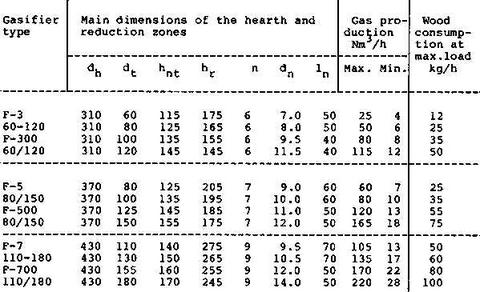This page describes a method to build wood-gasifier, or gas producer. It's better than anything we've seen under 1MWe. We also explain our understanding of why it works so well
Related page: MembersPage/MarcellGal/WoodGasifierEngine
We built about 15 downdraft gasifiers and run several experiments. The reason for this page is to save you from spending lotsof resources, time and grief while learning the hard way. If you're not familiar with the technology (yet) you can look up keywords (like FEMA, De-La-Cotte, Imbert) elsewhere. Probably reading again and again can help with better understanding (it's very hard to grab the concept for first reading).
How not to do it ? FEMA tarmaker!!!
FEMA is what we started with. We built several devices, and ran engines with them. FEMA design is probably the worst design that still works (that produces flammable gas). Besides the fuel moisture and fuel-size sensitivity it produces a LOT of tar. The FEMA docs says that it's for emergency. But even for emergency, the extreme amount of filtering (because of the tar-laden gases out of a FEMA) makes it worse choice than an Imbert. No surprise vedbil.se guys are so black when using FEMA (read their diary).
Why is FEMA so tar-laden? In short, the zones in the FEMA-tarmaker wander up and down, cooling the oxidation zone and creating a HUGE amount of tar (which is somewhat like mineral oil: good in some places, but not good when sticking the intake valve to its seat).
Imbert: better than FEMA
Imbert came up with a reasonable one-stage gasifier design. Usually used for 2-50 kWe but it's very easy to make it bigger. It's quite a challenge to make a good gasifier under 5kWe.
One embodiment guides air in tangentially, swirling in a toroid at a certain location, keeping temperature up and tar-forming down''':


Big gasifiers
Note that for 100-1000 kWe (typical powerplant cost is 800-1000 USD / kW, so the 1000 kWe is ~ 1 million dollar) the trickier 2-stage gasifier (an updraft and a downdraft or crossdraft combined) seems to be a better idea. It can burn fuel with higher moisture content, and bigger or smaller pieces as well. There are some reasonably good 2-stage gasifiers in Gussing, reaching up to 92% gasification efficiency (that might be a record).
Read about the De-La-Cotte tar-burning gasifier elsewhere.
Internal Tar Burning
The idea is to burn the relatively small amount of incoming air (only 1.6 kg for 1kg wood, giving 2.6kg woodgas) with tar-gases coming from the distillation of wood (not with "clean" char). Also, do this oxidation at a relatively high temp (1200C or higher). It's impossible to burn all the chars, but cracking most of them is possible. But only in the oxidation chamber. Do not expect to crack a lot of tars in the reduction area.
This tar-burning idea is not ours. Besides the De-La-Cotte gasifier that has separate tar-burning chamber, some designs maintain an airflow that helps react the O2 of incoming air with tarry gases. The monorator is one such.
A good example for small gasifier - marching towards the wholy grail ?
The holy grail is a gasifier that
- can burn chopped wood (chipping not needed)
- can burn relatively moist biomass (not only wood of course - even waste)
- can be operated with low flowrate
- Because of the hopper it will never be really small.
We do not claim to be able to do all these at the same time. But it seems that the first 2 targets can be achieved down to at least 2.4 kg/hour wood consumption.
Note that the gasifier was designed for 30-40kg/hour biomass, and mostly for a demo unit (we left improvements for later revision). It is not even completed: heat-recuperation is minimalistic (an external heat-recuperator is planned). And insulation is not particularly good.
We actually did not expect that it operates at 1/13 of the designed peak load (with less tar than a FEMA near design load), so we were a bit surprised.
Photos will follow
- A relatively big rectangular hopper, appr 550x550mm
- V at the bottom to allow char to flow down
- d=114mm horizontal auger (with thick shaft) reduction section at the bottom of the V
- many-many nozzles at the circumference at the top of the V
Operation (as far as we understand), apparently similar to the monorator:
- some of the high-temperature gases from oxidation zone flow into the auger
- some of the high-temperature gases from oxidation zone (from the bottom of the V) flow up
- than distill more fuel and turn down
- flow down at the sides
- mixes with incoming air, oxidizes and travels inwards to the bottom of the V
- the above repeats
Comparison with FEMA:
- in FEMA the tube is small dia. The monorator is the opposite: big diameter, therefore allowing the above gas-currents (up in the middle, down at the sides)
- FEMA has no nozzles. Monorator has nozzles to optimize the point where air comes in
- similarity: both are co-flow. Co-flow is often called downdraft, but in the monorator up-draft currents are also important. And in this implementation the reduction tube is actually horizontal